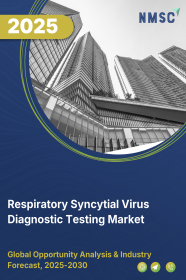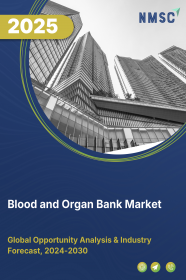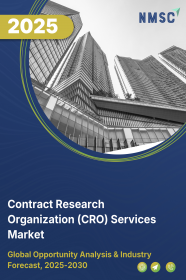
Respiratory Syncytial Virus (RSV) Diagnostic Testing Market by Method (Rapid Antigen Detection Test (RADT), Molecular Diagnostics, Chromatographic Immunoassay, and Others), by Product (Kits and Reagents, Instruments, and Others), and by End-User (Hospitals, Clinics, Laboratories, and Others) – Global Opportunity Analysis and Industry Forecast 2025-2030
US Tariff Impact on RSV Diagnostic Testing Market
Trump Tariffs Are Reshaping Global Business
Respiratory Syncytial Virus Diagnostic Testing Industry Overview
The global Respiratory Syncytial Virus (RSV) Diagnostic Testing Market size was valued at USD 2.80 billion in 2024 and is expected to be valued at USD 3.05 billion by the end of 2025. The industry is predicted to reach USD 4.80 billion by 2030 with a CAGR of 6.49% from 2025-2030.
The RSV diagnostic testing market growth is driven by the growing recognition of RSV’s substantial impact across all age groups, particularly beyond infants, which is fueling demand for improved diagnostics and prevention. Advancements in diagnostic technologies, including the shift to sensitive and rapid testing methods like multiplex assays, enhance early and accurate detection, further propelling the market expansion. The introduction of preventive interventions, such as long-acting monoclonal antibodies for infants and vaccines for older adults and younger at-risk adults, significantly boosts market potential.
However, challenges such as limited uptake of advanced testing in adult outpatient settings, difficulties in differentiating RSV from other illnesses, and the cost-effectiveness of vaccination strategies, compounded by insufficient awareness of RSV’s burden in non-infant populations, act as restraints. Despite these hurdles, opportunities arise from ongoing innovations in rapid point-of-care tests, multiplex assays, and increased awareness of RSV’s healthcare burden, driving demand for effective solutions and promising robust market growth.
Growing Recognition of RSV Burden Across Age Groups Propels the Respiratory Syncytial Virus Diagnostic Testing Market Growth
A key driver for the RSV diagnostic testing market trends is the increasing recognition of the substantial burden of RSV infection across all ages, moving beyond the traditional focus on infants. While RSV remains the most important cause of hospitalisation due to acute respiratory tract infection in infants under two years old, its significant impact on older adults is now more widely understood.
For instance, in high-income countries, RSV leads to millions of cases and significant hospitalisations and deaths in those aged 60 and over. Data from the USA also indicates that 1 in 20 adult outpatients diagnosed with RSV required hospitalisation, highlighting the considerable healthcare needs in this population. This growing awareness of RSV's broad impact and the associated healthcare utilisation is driving the demand for improved diagnostic tools and preventive measures, thereby fuelling the expansion of the RSV diagnostic testing market.
Advancements in Diagnostic Testing Technologies Drive the Industry
The development and increasing adoption of more sensitive and rapid diagnostic testing methods are other key drivers in the RSV diagnostics market expansion. Traditional methods like cell culture are being replaced by molecular assays, particularly reverse transcription polymerase chain reaction (RT-PCR), due to their higher sensitivity and faster turnaround times.
Furthermore, there is a trend towards multiplex PCR assays that simultaneously detect RSV and other respiratory pathogens. While challenges related to sensitivity and specificity in multiplex systems exist, advancements such as target-enriched multiplexing amplification are being explored to improve performance. For example, the Revealr-based diagnostic panel has shown high accuracy in detecting RSV, influenza A, influenza B, and SARS-CoV-2 in clinical samples. The increasing availability of these advanced diagnostic tools enables earlier and more accurate detection of RSV, contributing to market expansion as healthcare providers seek better diagnostic solutions.
Emergence of Preventive Interventions Surges the Respiratory Syncytial Virus Diagnostic Testing Market Expansion
The emergence of preventive interventions like vaccines and long-acting monoclonal antibodies is another factor driving the RSV diagnostic testing market demand. Nirsevimab (Beyfortus), a long-acting monoclonal antibody, has been approved for RSV prevention in all newborns and infants during their first RSV season and in high-risk children up to 24 months in their second season. Studies in Spain have shown it reduces RSV-related hospitalisations in infants under six months by 82%.
Vaccines for older adults (60 years and above), such as GSK's Arexvy and Pfizer's Abrysvo, have also been approved. These vaccines have demonstrated efficacy in preventing severe RSV-related lower respiratory tract illness and acute respiratory infection in this age group. Moderna's mRESVIA is another approved mRNA vaccine for adults 60 and older. This growing availability and recommendation for use in various populations are key factors propelling the growth of the RSV diagnostic testing market.
Challenges in Diagnosis and Vaccination is a Key Restraint in the Respiratory Syncytial Virus Diagnostic Testing Market
One restraint in the RSV diagnostic testing market lies in the ongoing challenges in achieving widespread and accurate diagnosis, particularly in adults. While RT-PCR is sensitive, its uptake in adult outpatient settings is limited, and differentiating RSV from other respiratory illnesses can be difficult. Furthermore, the cost-effectiveness of widespread vaccination strategies in different age groups and geographical locations is still being evaluated, with vaccine pricing being a significant factor influencing optimal strategies. The need for better awareness of RSV burden beyond infants also presents a restraint, as this understanding is crucial for driving demand for diagnostic and preventive measures in other vulnerable populations like older adults.
Recent Development and Approval of Preventive Interventions Acts as Emerging Opportunities Driving Growth in the RSV Diagnostic Testing Market
Significant opportunities exist in the RSV diagnostic testing market due to the recent development and approval of preventive interventions such as nirsevimab for infants and vaccines like Arexvy and Abrysvo for older adults. The expansion of approved use to include younger at-risk adults also presents a growing market.
Moreover, there is a strong drive for advancements in diagnostic technologies, including rapid point-of-care tests and multiplex assays for the simultaneous detection of respiratory pathogens. Increased awareness of the substantial healthcare burden and costs associated with RSV across all ages is further driving the demand for effective diagnostic, preventive, and therapeutic solutions, indicating a robust market potential.
Market Segmentations and Scope of the Study
The respiratory syncytial virus diagnostic testing market report is segmented on the basis of method, products, end-user, and region. On the basis of the method, the market is divided into rapid antigen detection test (RADT), molecular diagnostics, chromatographic immunoassay, and others. On the basis of product, the market is segmented into kits and reagents, instruments, and others. On the basis of end-user, the market is classified into hospitals, clinics, laboratories, and others. Regional breakdown and analysis of each of the aforesaid segments include regions comprising North America, Europe, Asia-Pacific, and RoW.
Geographical Analysis
The global RSV diagnostic testing market reveals distinct geographical dynamics influencing its market size and growth potential. In North America, the presence of key market players and regulatory approvals, such as the FDA's Emergency Use Authorization for combination tests and the launch of multiplex diagnostic assays, indicates a mature market with a focus on advanced testing methodologies.
Europe presents a complex landscape with ongoing research into the burden of RSV, particularly in older adults, and the initiation of vaccination programmes. The focus on cost-effectiveness analysis of potential interventions in countries like Denmark, Finland, the Netherlands, and Spain-Valencia highlights a region actively assessing strategies to manage RSV.
The Asia-Pacific region, particularly India and Korea, demonstrates a growing awareness of RSV's public health impact. Regulatory approvals for preventive therapies like Palivizumab in India and the launch of new diagnostic tests designed for global application but developed in India signal increasing market activity and growth in this region. The introduction of preventive antibodies in Korea further underscores this trend.
The Rest of the World encompasses various regions with differing levels of RSV surveillance and diagnostic capabilities. While global estimates from organisations like the WHO underscore the worldwide burden of RSV, specific developments in other regions are less. However, the global applicability of diagnostic tests developed in regions like Asia-Pacific suggests a growing worldwide RSV diagnostic testing market revenue.
Strategic Analysis of the Companies Operating in the Market
Key players in the global respiratory syncytial virus diagnostic testing industry are actively pursuing strategies focused on enhancing the speed, sensitivity, and breadth of available tests to capture a larger market share and address the significant growth potential in this area.
Recent developments include the advancement of rapid molecular tests and the development of sensitive nucleic acid amplification assays, particularly reverse transcription polymerase chain reaction (RT-PCR) and real-time PCR, which are increasingly replacing cell culture as the preferred method due to their higher sensitivity and faster turnaround times. There's also a trend towards developing multiplex PCR assays capable of simultaneously detecting RSV and other respiratory pathogens, although challenges remain in achieving comparable sensitivity and specificity to single-target assays.
For instance, HaystackAnalytics recently launched a diagnostic test to detect bacterial, fungal, and respiratory RNA viruses, including RSV, highlighting the move towards broader respiratory panels. A key challenge for industry players lies in overcoming the reduced sensitivity and specificity sometimes associated with multiplex systems, as well as the high costs and limited standardisation of nucleic acid-based tests. However, significant opportunities exist in further refining target-enriched multiplexing amplification and the use of padlock probe designs to improve the performance of these comprehensive tests.
Moreover, the exploration and validation of alternative specimen types like sputum and saliva, particularly for diagnosing RSV in adults, as demonstrated by studies showing increased detection rates with these methods in addition to nasopharyngeal swabs, presents a considerable opportunity to expand the market and improve diagnostic accuracy across different age groups. Future research is also focusing on developing cost-effective test systems suitable for widespread screening and adapting testing protocols based on seasonal epidemiological data, which could further shape market trends and industry size.
Key Benefits
-
The report provides quantitative analysis and estimations of the of respiratory syncytial virus diagnostic testing sector from 2025 to 2030, which assists in identifying the prevailing market opportunities.
-
The study comprises a deep dive analysis of the of market, including the current and future trends to depict prevalent investment pockets in the market.
-
Information related to key drivers, restraints, and opportunities and their impact on the market is provided in the report.
-
Competitive analysis of the players, along with their market share is provided in the report.
-
SWOT analysis and Porter's Five Forces model are elaborated in the study.
-
Value chain analysis in the market study provides a clear picture of roles of stakeholders.
Respiratory Syncytial Virus Diagnostic Testing Market Key Segments
By Method
-
Rapid Antigen Detection Test (RADT)
-
Molecular Diagnostics
-
Chromatographic Immunoassay
-
Others
By Product
-
Kits and reagents
-
Instruments
-
Others
By End-User
-
Hospitals
-
Clinics
-
Laboratories
-
Others
By Region
-
North America
-
The U.S.
-
Canada
-
Mexico
-
-
Europe
-
The UK
-
Germany
-
France
-
Italy
-
Spain
-
Denmark
-
Netherlands
-
Finland
-
Sweden
-
Norway
-
Russia
-
Rest of Europe
-
-
Asia-Pacific
-
China
-
Japan
-
India
-
South Korea
-
Australia
-
Indonesia
-
Singapore
-
Taiwan
-
Thailand
-
Rest of Asia-Pacific
-
-
RoW
-
Latin America
-
Middle East
-
Africa
-
Key Players
-
Becton Dickinson and Company
-
F. Hoffmann-La Roche Ltd
-
Thermo Fisher Scientific Inc
-
Luminex Corporation
-
Sonora Quest Laboratories
-
Merck KGaA
-
Abbott Laboratories
-
Siemens Healthineers AG
-
Danaher Corporation
-
Hologic, Inc.
-
Cepheid
-
Roche Diagnostics
REPORT SCOPE AND SEGMENTATION:
|
Parameters |
Details |
|
Market Size in 2024 |
USD 2.80 Billion |
|
Revenue Forecast in 2030 |
USD 4.08 Billion |
|
Growth Rate |
CAGR of 6.49% from 2025 to 2030 |
|
Analysis Period |
2025–2030 |
|
Base Year Considered |
2024 |
|
Forecast Period |
2026–2030 |
|
Market Size Estimation |
Billion (USD) |
|
Growth Factors |
|
|
Countries Covered |
28 |
|
Companies Profiled |
15 |
|
Market Share |
Available for 10 companies |
|
Customization Scope |
Free customization (equivalent up to 80 working hours of analysts) after purchase. Addition or alteration to country, regional, and segment scope. |
|
Pricing and Purchase Options |
Avail customized purchase options to meet your exact research needs. |

















 Speak to Our Analyst
Speak to Our Analyst





















